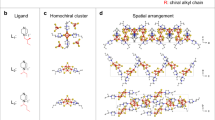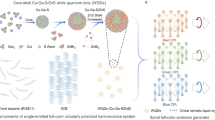Abstract
The high optical and chemical activity of nanoparticles (NPs) signifies the possibility of converting the spin angular momenta of photons into structural changes in matter. Here, we demonstrate that illumination of dispersions of racemic CdTe NPs with right- (left-)handed circularly polarized light (CPL) induces the formation of right- (left-)handed twisted nanoribbons with an enantiomeric excess exceeding 30%, which is ∼10 times higher than that of typical CPL-induced reactions. Linearly polarized light or dark conditions led instead to straight nanoribbons. CPL ‘templating’ of NP assemblies is based on the enantio-selective photoactivation of chiral NPs and clusters, followed by their photooxidation and self-assembly into nanoribbons with specific helicity as a result of chirality-sensitive interactions between the NPs. The ability of NPs to retain the polarization information of incident photons should open pathways for the synthesis of chiral photonic materials and allow a better understanding of the origins of biomolecular homochirality.
This is a preview of subscription content, access via your institution
Access options
Subscribe to this journal
Receive 12 print issues and online access
$259.00 per year
only $21.58 per issue
Buy this article
- Purchase on Springer Link
- Instant access to full article PDF
Prices may be subject to local taxes which are calculated during checkout




Similar content being viewed by others
References
Ren, M. X., Plum, E., Xu, J. J. & Zheludev, N. I. Giant nonlinear optical activity in a plasmonic metamaterial. Nature Commun. 3, 833 (2012).
Kuzyk, A. et al. DNA-based self-assembly of chiral plasmonic nanostructures with tailored optical response. Nature 483, 311–314 (2012).
Guerrero-Martinez, A. et al. Intense optical activity from three-dimensional chiral ordering of plasmonic nanoantennas. Angew. Chem. Int. Ed. 50, 5499–5503 (2011).
Liu, S. et al. Synthesis of chiral TiO2 nanofibre with electron transition-based optical activity. Nature Commun. 3, 1215 (2012).
Chen, W. et al. Nanoparticle superstructures made by polymerase chain reaction: Collective interactions of nanoparticles and a new principle for chiral materials. Nano Lett. 9, 2153–2159 (2009).
Mark, A. G., Gibbs, J. G., Lee, T. C. & Fischer, P. Hybrid nanocolloids with programmed three-dimensional shape and material composition. Nature Mater. 12, 802–807 (2013).
Ma, W. et al. Attomolar DNA detection with chiral nanorod assemblies. Nature Commun. 4, 2689 (2013).
Gansel, J. K. et al. Gold helix photonic metamaterial as broadband circular polarizer. Science 325, 1513–1515 (2009).
Toyoda, K., Miyamoto, K., Aoki, N., Morita, R. & Omatsu, T. Using optical vortex to control the chirality of twisted metal nanostructures. Nano Lett. 12, 3645–3649 (2012).
Brachmann, J. F. S., Bakr, W. S., Gillen, J., Peng, A. & Greiner, M. Inducing vortices in a Bose–Einstein condensate using holographically produced light beams. Opt. Express 19, 12984–12991 (2011).
Tabosa, J. W. R. & Petrov, D. V. Optical pumping of orbital angular momentum of light in cold cesium atoms. Phys. Rev. Lett. 83, 4967–4970 (1999).
Padgett, M. & Bowman, R. Tweezers with a twist. Nature Photon. 5, 343–348 (2011).
Tang, Y. Q. & Cohen, A. E. Enhanced enantioselectivity in excitation of chiral molecules by superchiral light. Science 332, 333–336 (2011).
Feringa, B. L. & van Delden, R. A. Absolute asymmetric synthesis: The origin, control, and amplification of chirality. Angew. Chem. Int. Ed. 38, 3419–3438 (1999).
Green, M. M. & Selinger, J. V. Cosmic chirality. Science 282, 880–881 (1998).
Bailey, J. et al. Circular polarization in star-formation regions: Implications for biomolecular homochirality. Science 281, 672–674 (1998).
Girl, C. et al. Synthesis and chirality of amino acids under interstellar conditions. Top. Curr. Chem 333, 41–82 (2013).
Cronin, J. R. & Pizzarello, S. Enantiomeric excesses in meteoritic amino acids. Science 275, 951–955 (1997).
Prins, L. J., Timmerman, P. & Reinhoudt, D. N. Amplification of chirality: The “sergeants and soldiers” principle applied to dynamic hydrogen-bonded assemblies. J. Am. Chem. Soc. 123, 10153–10163 (2001).
Gautier, C. & Burgi, T. Chiral N-isobutyryl-cysteine protected gold nanoparticles: Preparation, size selection, and optical activity in the UV–vis and infrared. J. Am. Chem. Soc. 128, 11079–11087 (2006).
Chen, C. C. et al. Three-dimensional imaging of dislocations in a nanoparticle at atomic resolution. Nature 496, 74–77 (2013).
Govorov, A. O., Fan, Z. Y., Hernandez, P., Slocik, J. M. & Naik, R. R. Theory of circular dichroism of nanomaterials comprising chiral molecules and nanocrystals: Plasmon enhancement, dipole interactions, and dielectric effects. Nano Lett. 10, 1374–1382 (2010).
Ben Moshe, A., Szwarcman, D. & Markovich, G. Size dependence of chiroptical activity in colloidal quantum dots. ACS Nano 5, 9034–9043 (2011).
Talapin, D. V. et al. Quasicrystalline order in self-assembled binary nanoparticle superlattices. Nature 461, 964–967 (2009).
Srivastava, S. et al. Light-controlled self-assembly of semiconductor nanoparticles into twisted ribbons. Science 327, 1355–1359 (2010).
Bustamante, C., Maestre, M. F. & Tinoco, I. Circular intensity differential scattering of light by helical structures. 1. Theory. J. Chem. Phys. 73, 4273–4281 (1980).
Tang, Z. Y., Kotov, N. A. & Giersig, M. Spontaneous organization of single CdTe nanoparticles into luminescent nanowires. Science 297, 237–240 (2002).
Gaponik, N. et al. Thiol-capping of CdTe nanocrystals: An alternative to organometallic synthetic routes. J. Phys. Chem. B 106, 7177–7185 (2002).
Dolamic, I., Knoppe, S., Dass, A. & Burgi, T. First enantioseparation and circular dichroism spectra of Au38 clusters protected by achiral ligands. Nature Commun. 3, 798 (2012).
Hartland, A., Lead, J. R., Slaveykova, V. I., O’Carroll, D. & Valsami-Jones, E. The environmental significance of natural nanoparticles. Nature Educ. Knowl. 4, 7 (2013).
Acknowledgements
This material is based on work partially supported by the Center for Solar and Thermal Energy Conversion, an Energy Frontier Research Center funded by the US Department of Energy, Office of Science, Office of Basic Energy Sciences under award number #DE-SC0000957, and by ARO MURI W911NF-12-1-0407 ‘Coherent Effects in Hybrid Nanostructures for Lineshape Engineering of Electromagnetic Media’ (N.A.K. and S.L.). We acknowledge support from the NSF under grant ECS-0601345; CBET 0933384; CBET 0932823; and CBET 1036672. Financial support from the Robert A. Welch Foundation (C-1664) is also acknowledged (S.L.). Support from the NIH grant GM085043 (P.Z.) is gratefully acknowledged. The work of P.K. was supported by the NSF DMR grant No. 1309765 and by the ACS PRF grant No. 53062-ND6. The authors thank J-Y. Kim for assistance with chiral NP assembly experiments.
Author information
Authors and Affiliations
Contributions
N.A.K. conceived the project. J.Y. built the experimental set-up and performed the experiments. B.Y. carried out ME-FEM simulations. H.C. and P.K. undertook atomistic MD simulations. K.W.S., S.D-M., W-S.C. and S.L. measured CD signals from a single nanoribbon. J.H.B. conducted E-DLVO calculations and synthesis of L- and D-cysteine-stabilized CdTe nanostructures. G.Z. and P.Z. carried out 3D TEM tomography. S-J.C. conducted AFM measurements. A.C., D.M. and A.L.R. measured high-resolution HAADF and TEM images of truncated tetrahedral CdTe NPs. J.Y., B.Y. and N.A.K. analysed data. J.Y. and N.A.K. wrote the manuscript.
Corresponding author
Ethics declarations
Competing interests
The authors declare no competing financial interests.
Supplementary information
Supplementary Information
Supplementary Information (PDF 2647 kb)
Rights and permissions
About this article
Cite this article
Yeom, J., Yeom, B., Chan, H. et al. Chiral templating of self-assembling nanostructures by circularly polarized light. Nature Mater 14, 66–72 (2015). https://doi.org/10.1038/nmat4125
Received:
Accepted:
Published:
Issue Date:
DOI: https://doi.org/10.1038/nmat4125
This article is cited by
-
Progress and prospects of chiral nanomaterials for biosensing platforms
Rare Metals (2024)
-
Bioinspired chiral inorganic nanomaterials
Nature Reviews Bioengineering (2023)
-
Asymmetric transformation of achiral gold nanoclusters with negative nonlinear dependence between chiroptical activity and enantiomeric excess
Nature Communications (2023)
-
Circularly Polarized Light-Enabled Chiral Nanomaterials: From Fabrication to Application
Nano-Micro Letters (2023)
-
Chiral inorganic nanomaterials: Harnessing chirality-dependent interactions with living entities for biomedical applications
Nano Research (2023)



